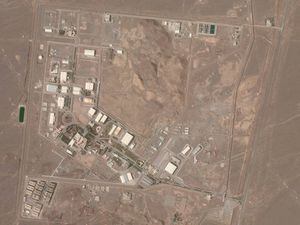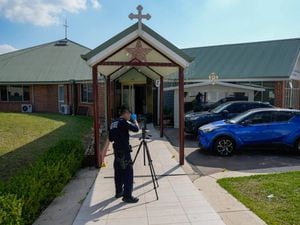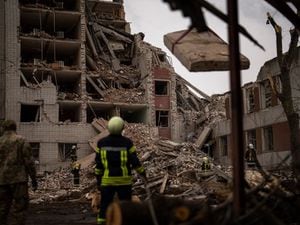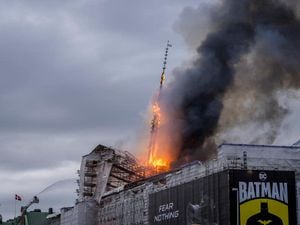‘Suspicious’ blackout strikes Iran’s Natanz nuclear site
Multiple Israeli media outlets reported on Sunday that a cyber attack had caused the blackout.

Iran’s underground Natanz nuclear facility lost power on Sunday, just hours after starting up new advanced centrifuges capable of enriching uranium faster.
It is the latest incident to strike the site amid negotiations over the troubled atomic accord with world powers.
As Iranian officials investigated the outage, many Israeli media outlets suggested it was a cyber attack.
While the reports offered no source for the assessment, Israeli media maintains a close relationship with the country’s military and intelligence agencies.
If Israel caused the blackout, it further heightens the tensions between the two nations which are already engaged in a shadow conflict across the wider Middle East.
It also complicates efforts by the US, Israel’s main security partner, to re-enter the atomic accord aimed at limiting Tehran’s programme so it cannot develop a nuclear weapon.

Power at Natanz was cut across the whole facility, which comprises above-ground workshops and underground enrichment halls, civilian nuclear programme spokesman Behrouz Kamalvandi told Iranian state television.
“We still do not know the reason for this electricity outage and have to look into it further,” he said. “Fortunately, there was no casualty or damage and there is no particular contamination or problem.”
Asked by a state TV correspondent if it was a “technical defect or sabotage”, Mr Kamalvandi declined to comment.
Malek Shariati Niasar, a Tehran-based politician who serves as spokesman for the Iranian parliament’s energy committee, wrote on Twitter that the incident was “very suspicious”, raising concerns about possible “sabotage and infiltration”.
He said politicians are also seeking details of the incident.
The Vienna-based International Atomic Energy Agency, which monitors Iran’s programme, said it was “aware of the media reports”, but declined to comment.
Natanz was largely built underground to withstand enemy air strikes. It became a flashpoint for Western fears about Iran’s nuclear programme in 2002, when satellite photos showed Iran building its underground centrifuges facility at the site, some 125 miles (200km) south of the capital, Tehran.
Natanz suffered a mysterious explosion at its advanced centrifuge assembly plant in July which authorities later described as sabotage. Iran is now rebuilding that facility deep inside a nearby mountain.
Israel, Iran’s regional arch enemy, has been suspected of carrying out that attack as well as launching other assaults, as world powers now negotiate with Tehran in Vienna over its nuclear deal.
Iran also blamed Israel for the killing of a scientist who began the country’s military nuclear programme decades earlier. The Stuxnet computer virus, discovered in 2010 and widely believed to be a joint US-Israeli creation, once disrupted and destroyed Iranian centrifuges at Natanz.
Israel has not claimed any of the attacks, though Mr Netanyahu has repeatedly described Iran as a major threat to his country.
Meeting Mr Austin on Sunday, Mr Gantz said Israel views America as an ally against all threats, including Iran.
“The Tehran of today poses a strategic threat to international security, to the entire Middle East and to the state of Israel,” he said.
“And we will work closely with our American allies to ensure that any new agreement with Iran will secure the vital interests of the world, of the United States, prevent a dangerous arms race in our region, and protect the state of Israel.”
The Israeli army’s chief of staff, Lieutenant General Aviv Kochavi, also appeared to refer to Iran.
The Israeli military’s “operations in the Middle East are not hidden from the eyes of the enemy”, he said. “They are watching us, seeing (our) abilities and weighing their steps with caution.”
Multiple Israeli media outlets reported on Sunday that a cyber attack had caused the blackout in Natanz.
Public broadcaster Kan said Israel was likely to have been behind the attack, citing Israel’s alleged responsibility for the Stuxnet attacks a decade ago.
Channel 12 TV cited “experts” as estimating the attack shut down entire sections of the facility.
None of the reports included sources or explanations on how the outlets came to that assessment.

On Friday, Iran released a South Korean oil tanker held since January amid a dispute with Seoul over billions of dollars of its assets frozen there.
On Saturday, Iran announced that it had launched a chain of 164 IR-6 centrifuges at the plant.
Officials also began testing the IR-9 centrifuge, which they say will enrich uranium 50 times faster than Iran’s first-generation centrifuges, the IR-1. The nuclear deal limited Iran to using only IR-1s for enrichment.
Since then-President Donald Trump withdrew the US from the Iran nuclear deal in 2018, Tehran has abandoned all the limits of its uranium stockpile. It now enriches up to 20% purity, a technical step away from weapons-grade levels of 90%.
Iran maintains its atomic programme is for peaceful purposes, but fears about Tehran having the ability to make a bomb saw world powers reach the deal with the Islamic Republic in 2015.
The deal lifted economic sanctions on Iran in exchange for it limiting its programme and allowing IAEA inspectors to keep a close watch on its work.
On Tuesday, an Iranian cargo ship said to serve as a floating base for Iran’s paramilitary Revolutionary Guard forces off the coast of Yemen was struck by an explosion, most likely from a limpet mine.
Iran has blamed Israel for the blast. That attack escalated a long-running shadow war in Mideast waterways targeting shipping in the region.





